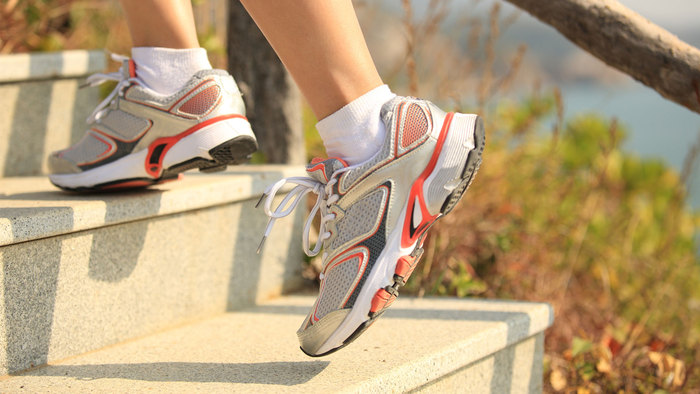Blog »
How many calf raises should runners be able to do?
Published 19 August 2019. Written by Chris Worfolk.

Runners have to worry about all sorts of things: ankles, knees, feet, hamstrings to name a few. But for some, one area is more problematic than any other: the calf.
To keep the calf injury-free, it is important to do strength exercises if you are going to do a lot of running. Calf raises, single-leg squats and lunges are all useful for this. But how strong is strong? In this article, we will answer that question.
The answer
Before I go into the details, I will give you the answer. Plain and simply, it is about 25 on each leg. If you can do this, you are doing well. If not, some more strength work is advised.
Specifically, this is a single-leg calf raise on a step. I will go into detail about how to do this below.
Why is single leg work important?
We runners put a lot of strain on our legs. That strain is specific: if you think about doing a marathon, you are performing the same action over and over again for hours at a time.
This makes it much harder on our bodies than over sports. For example, if you play football, you will ache like hell the first few times you train because you will use muscles you never knew you had. But no muscle gets continuously worked because of the range of different movements.
Running is different. It is one leg in front of the other, in the same pattern if you are keeping a constant pace. Therefore, it is essential that we keep these key muscles strong to protect them from injury.
How to do a calf raise
If you are new to calf raises, you can start by standing flat on the floor. Slowly and with control, raise your heels up and then place them down again. You can start doing both feet at the same time to make it easier.
As you progress, you will want to move on to using a step and doing one leg at a time. If your house has steps, these work great. Yoga blocks are also good, but any surface will do. If you are old enough to remember the Yellow Pages, that would also work.
Put your toes on the edge of the step with your heels hanging off the back. It is the same motion: raise your heels up and then slowly lower them. You do not need to go too far beyond horizontal on the way down, but the lower you go, the more challenging it will be.
Balancing on one leg can be difficult, so you may want to do it next to a wall or piece of furniture that you can use to help you balance.
Getting started
Start by doing three sets of ten with both legs on the floor. Then move onto a step. Then do one leg. Once you are comfortable doing ten on each side, you can start increasing the reps.
If you cannot do ten without really straining, knock it back and build up from whatever you can comfortably achieve.
Similarly, if you already have strong legs and can do more than ten, start with more reps.
Why is 25 the magic number?
25 is not a magic number as such, but it is a useful guide. Both Matt Klein from Doctor's of Running and Alison Rose, as quoted in Runner's World, recommended 25 as the minimum number to aim for.
Summary
Stronger calves are likely to be injury-free calves, so doing more calf raises is always helpful. But, as a baseline, you want to be aiming to do 25 on each leg. If you cannot do this, it is worth paying extra attention to them until you can.